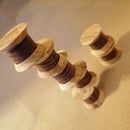Introduction: Easter Tiki Egg
It dawned on me that I don't do nearly enough to celebrate holidays.
(I justified this in the past with the thaught .. I would put in a lot of work and effort for one day, or I could make things that are going to be awesome all year round. But I'm starting to think that when something is only one day that makes it a little more special)
As a result here is my first ever Easter tiki.
Step 1: make a Sketch to Prepare Your Self Where You Will Want to Carve
make a sketch to prepare your self where you will want to carve
When I make props for TV often times people just trust me to do the work and do it well because they are in a rush and want props as soon as possible. But when I make my best work I sketch it out first.
This allows me to really get to grips with what i'm making and work out where things should go / how they should fit together and really engage with what im makeing.
Step 2: Grab a Blank for Your Wooden Egg an Find Its Centre
Grab a blank for your wooden egg an find its centre.
Wood turning is by far the easiest way to make an egg shape in wood.
I'm using a chunk of sapele but later on wished it was beach. sapele isn't as fun to carve and I happened to have a chunk of beach sitting next to me throughout the project.. (sitting there mocking me for not using it.. you know as non sentient things do)
Step 3: Turn a Chucking Point Between Centers and Chuck It Up.
Turn a chucking point between centers and chuck it up.
Its standard wood turning procedure.
If you're not familiar with woodturning but are considering getting into it this will be useful to you:
I would reccomend if you are new to turning finding a turning club near you.. Trust me there will be a ton of people who will be more than happy to give you advice an pointers.
Check out the web an look at videos.. you can learn a lot from watching other people.
If you have a set of tools an a lathe then this is for you:
For this I used a roughing gouge and a spindle gouge.. Always approach the wood bavel first and then introduce the cutting edge..
Also make sure your wearing a face shield an dust mask..
An try to be as safe as possible. (everyone has had a catch at one point or another.. the key is to learn from your mistakes)
Step 4: Turn Your Egg
I could explain the rule of 3rd's and how the widest part of an egg tends to be at around the paint 1/3 the high of the egg. But I have seen a whole bunch of different egg shapes and wouldn't want to discourage anyone from making something like an oviraptor egg.
My method for turning tends to be using the roughing gouge to do the heavy lifting and getting a rough shape and then refining it with the spindle gouge.
Step 5: Turn Down to Where You Feel Comfortable and Then Saw the Egg Off the Blank
Turn down to where you feel comfortable and then saw the egg off the blank.
I know some people who will turn an object free.
I think this needs a bit of confidence and I wouldn't want to encourage something which could potentially throw a wooden egg at you.
Step 6: Carve Away Your Unsightly Lump
I find when carving Its important to find a good way to hold the workpiece.
Luckily I can use the tool I have been using so far to do this :D
I created a slight dish in the blank and used a cup shaped revolving centre to hold the work in place.
Then locked the chuck in place.
I carved the lump off the bottom of the egg by holding the peace in place and aproaching the lump useing the same angle as the egg shape
Step 7: Use Your Sketch to Work Out Where You Want Your Tiki Carving to Go
Use your sketch to work out where you want your tiki carving to go
Chances are you will come up with better ways/ better places for details to go during this point.
The key part is to make sure you can understand where to carve. (I drew on with a felt tip for illustration purposes.. you might find a felt tip to be to leave too thick of a mark)
Step 8: Carve Out the Lines You Just Made
Carve out the lines you just made
I like to cut down and then meet this cut with a sideways cut with ant carving tool.
(This point is likely to take a bit of time but its rewarding seeing the job as it progresses)
Step 9: Get Rid of the Felt Tip Marks and Play With Finishing
Get rid of the felt tip marks and play with finishing
I was left with a few felt tip marks I didn't need after carving.
I sanded these away before disting the egg down.. (I know some people who swear by oo wire wool for displacing sanding dust.. I tend to use compressed air or a dusting brush.. this is partly because I know fragments of wire wool can react with finnish and make an otherwise awesome looking work look a bit naff.. (I know i'm working rustick with this one but the theory works for finer works))
For this egg I used some spirit die before using acrylic paint to highlight some of the details and then knocked it all back with another covering of stain and sanded the whole thing to encourage a greater gradience in wood tone. (props people would call this "ageing")

Grand Prize in the
Egg Challenge













